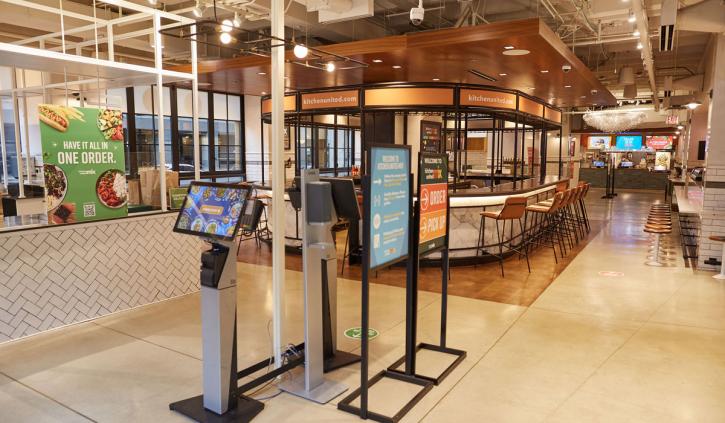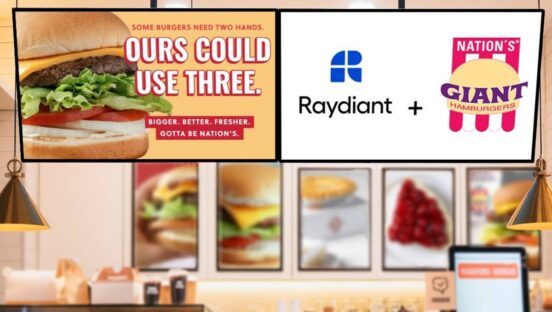






Tech on the mind
The last two years have been transformative for every sector, but perhaps none more so than the restaurant industry. Brands have had to develop new operating models, pivoting multiple times in a matter of a few short months in order to keep pace with consumer expectations and various regulations. And technology took center stage in this transformation of our industry.
As we head into a new year, brands are looking to both optimize their AI and machine learning initiative to keep their operations efficient, and looking to define new points of leverage to meet ever changing—and rising—customer expectations.
Here’s a look at how technology will continue to shape the restaurant industry in 2022.
Hybrid operating models will accelerate automation and AI
As brands get back to a steady state of dine-in demand with off-premises order volumes remaining high, many restaurants are seeing transaction volumes larger than pre-pandemic levels. Couple that with challenges in recruiting and retaining staff, and restaurants will have to operate in a hybrid environment with the same kitchen capacity.
It will be important to utilize restaurant technology solutions, such as kitchen automation, to improve efficiency and customer satisfaction. Adopting natural language processing (NPL), machine learning, and AI technologies can deliver data and insights that can help keep costs down and profits up.
For example, AI can help predict exactly when more inventory will be needed based on customer buying patterns and existing supply. Not only does this ensure the restaurant has the right food in place to fulfill orders and keep customers happy, but also helps the bottom line by reducing food waste (also a win for the environment).
The challenge of introducing natural language processing will be in helping tune your NLP AI engine to continuously improve accuracy. For example, “I want a plain cheeseburger” means different things to different people. To some, it means a burger patty on a bun, while for others it is a burger patty with cheese on a bun, and for some it just means a burger patty with cheese. Leveraging transaction data to help continuously improve data models will help restaurants better leverage NLP to automate everything from customer interactions to inventory management.
Restaurateurs will put their transaction data to work
Restaurant technology solutions must be about more than just handling transactions. Every interaction with a customer is an opportunity to improve day-to-day decision-making, and long-term business strategy.
In 2022, restaurant operators will focus on putting transaction data to work to better predict inventory demand, maintain a healthy connection with their suppliers, reduce waste, control costs, and remain agile. Transaction data can also help inform staff scheduling and labor costs.
Brands that centralize on a single restaurant management platform can optimize their operations data to improve both employee and customer satisfaction in 2022 and beyond.
Off-premises demand will drive growth of virtual brands and ghost kitchens
The hybrid operating environment is starting to show its impact on customer satisfaction. Consumers have a low tolerance for wait times, both during the ordering process and while waiting to be served. According to our latest restaurant consumer trends research 45 percent of consumers feel they have to wait way longer for their in-person order, compared to drive-thru and order ahead, and 29 percent of U.S. consumers are annoyed within two minutes when waiting to place an order at a counter.
Given this low threshold for wait times, and sense of deprioritization for dine-in customers, we are going to see brands increase their investments in off-premises business models, such as virtual brands or ghost kitchens to keep costs down, protect the brand, and maximize their labor force.
The challenge will be for brands to deliver a consistent experience across their menu, pricing, promotions, and customer service, across each operating model. It is also important to ensure that the brand, product, packaging and standards are consistent.
New approaches to loyalty and anonymous customer engagement
In the last year, we saw consumers rally behind independent brands, and clearly define their loyalty to restaurants over third-party aggregators. That loyalty however can wane in the face of inconvenience. Offering customers the option to pay however they desire will be increasingly important with the utilization of cash on the decline.
This creates significant opportunity for operators to put their payment data to work—to create customized experiences and personal offers, even when customers are not members of a loyalty program or active in the branded app. An anonymous personalization program, will provide value to end-consumers, compelling them to self-identify, opt-in, and create a long-term authentic, direct relationship with their favorite eateries.
Supply chain management will become a moral, financial, and new customer acquisition imperative
Consumer demand for more supply chain transparency will drive brands to adopt restaurant technology solutions to maintain a healthy connection with their suppliers, help ensure supplier data integrity, and share accurate data to consumers throughout the buying process.
We’ll also see increased adoption of sophisticated inventory planning and forecasting, supported by transaction data. By analyzing information down to the individual check level, restaurateurs can help predict demand so they can better manage their inventory, control costs, and reduce waste.
The battle for talent will get worse before it gets better
Last year we predicted that closures, layoffs, and furloughs that drove workers out of the food and beverage industry would create an environment where attracting and retaining talent would be difficult and fiercely competitive. We had no idea how accurate that prediction would become.
Now more than ever, restaurant owners need to lean heavily on technology that is intuitive, easily integrated with existing systems, and offers staff flexibility in managing shifts, swapping with peers, and freedom to work at different locations if feasible.
Beyond technology, brands will also have to differentiate themselves—both to employees and customers—through core values and culture. The importance of environmental, sustainability, and corporate governance (ESG) is not only relevant to consumers—it’s key to building teams and customers that become brand champions.
Chris Adams has over 20 years’ experience in the hospitality technology industry. Following time with Marriott, Chris began his career at MICROS (now Oracle Food and Beverage) in 2000 and has worked across many positions throughout his tenure, including operations, customer success, consulting and sales. Having worked in multiple countries and regions, Chris was Managing Director of Australia prior to the Oracle acquisition. Today, with his passion to see our customers succeed, Chris drives the strategy for Oracle Food and Beverage’s global portfolio as Global VP Strategy and Solutions. He is based in Maryland when not traveling the world spending time with our team, customers and partners.









